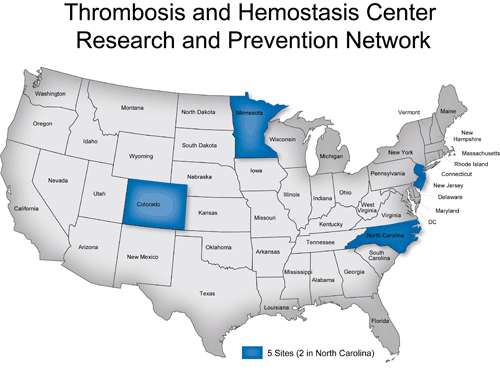Research & Treatment Centers
CDC supports the Thrombosis and Hemostasis Centers Research and Prevention Network to foster collaborative epidemiologic research designed to identify risks for DVT/PE among the U.S. population. Findings from this research will ultimately be used to improve diagnosis and treatment of these conditions. The centers collect data from patients of all ages and races while providing services to patients with DVT/PE and other thrombotic conditions. Currently, CDC funds five centers. These centers have multidisciplinary teams of health care specialists and state-of-the art clinical research programs that provide outreach and education programs for patients. Below is the contact information for these centers.

Colorado
Hemophilia and Thrombosis Center
University of Colorado Denver
13001 E. 17th Place
Aurora, CO 80045-0507
Phone (303) 724-0365
Website
Minnesota
Mayo Clinic
Coagulation Laboratories and Clinic
200 First Street SW
Rochester, MN 55905
(507) 284-2677
Website
New Jersey
Robert Wood Johnson Medical School Thrombosis Center
Clinical Academic Building
125 Paterson Street
New Brunswick, NJ 08903
Phone: (732) 235-7223
Website
North Carolina
Hemostasis and Thrombosis Center
Duke University Health System
Box 3422
Room 0563 Stead Building
Durham, NC 27710
Phone: (919) 684-5350
Website
Hemophilia and Thrombosis Center
University of North Carolina School of Medicine
CB 7016
Chapel Hill, NC 27599
Phone: (919) 966-4736
Website
CDC also supports a network of hemophilia treatment centers, many of which also offer care to people with thrombosis and thrombophilia.
Contact Us:
- Centers for Disease Control and Prevention
National Center on Birth Defects and Developmental Disabilities
Division of Blood Disorders
1600 Clifton Road
MS E-64
Atlanta, GA 30333 - 800-CDC-INFO
(800-232-4636)
TTY: (888) 232-6348
New Hours of Operation
8am-8pm ET/Monday-Friday
Closed Holidays - cdcinfo@cdc.gov


